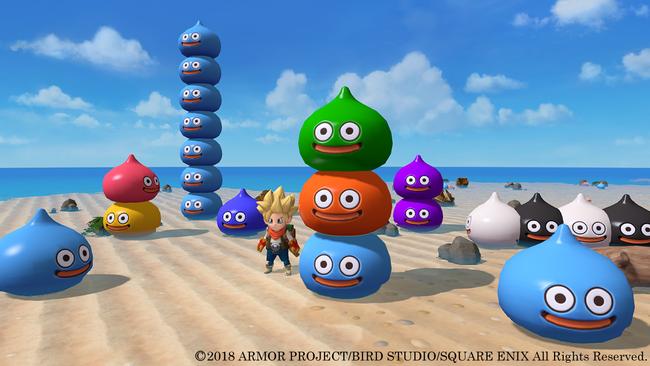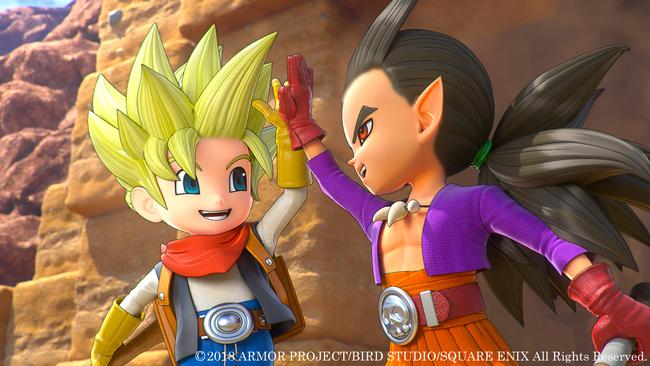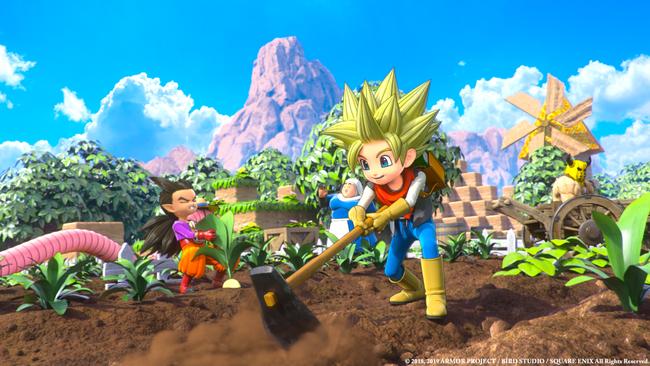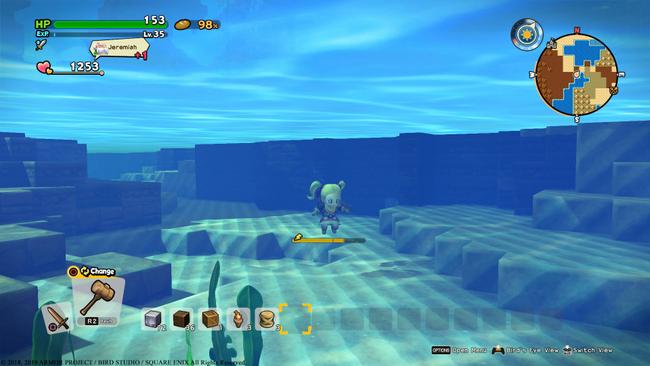
Dragon Quest Builders 2 Interview at E3 2019: We talk with Square Enix about the expanding world of Dragon Quest
Dragon Quest Builders 2 launches pretty soon here, next month on July 12 for PlayStation 4 and Nintendo Switch. We got a chance to play the demo at E3 2019, and you can check out James' hands-on impressions of the game here.
Additionally though, during E3 2019 I got a chance to discuss, through company translators, the game and sub-series with Square Enix leads Noriyoshi Fujimoto (Producer), Takuma Shiraishi (Producer), and Kazuya Niinou (Director) as a part of a round-table discussion.

New to Dragon Quest Builders 2 is the addition of gliding around your build area as well as being able to traverse through water. Director Niinou discussed why he wanted to bring these elements to the sequel, as well as other elements he felt should be in a game like this.
Niinou: Gliding or flying and creating water surfaces and being able to jump in water, these are all elements that I felt should be in a sandbox game. In fact, it was a little bit embarrassing that these elements weren't in the first installment to begin with. Aside from that, though, the aspects that we really want people to take note of and look into are those where you can build together with NPC characters, or get a glimpse of their life in the environment that you created. Those are the types of things we'd love for players to take note of. Also, the notice board function that allows players to share photos of their creations with other players and the community, both the terrain and designs. These sorts of features that aren't available in other sandbox titles.
RPG Site: What sort of feedback did you receive regarding the first installment of Dragon Quest Builders, and how were you able to address those criticisms in the sequel?
Niinou: The largest aspect that we changed up from the previous installment based on player feedback was how the first game included two separate modes: the Free Build mode and the Story Mode. Players weren't able to bring creations from the Story Mode to Free Mode, and that especially was something people asked us to fix. So, in Dragon Quest Builders 2, these two modes are now somewhat intertwined. The Isle of Awakening is something you'll continue to build on as you progress through the story. You'll befriend certain NPCs and characters along the way, and you can potentially bring them back to your island and further expand on your building. The system has completely changed in that regard, and player feedback is a big reason why.
RPG Site: Multiplayer is a new element added to Dragon Quest Builders 2. Can you explain how this is incorporated into the game?
Shiraishi: Dragon Quest Builders did not have a multiplayer feature and it was a completely single-player game. In Dragon Quest Builders 2, you can bring your friends to the Isle of Awakening that you are developing, and you can take them along to separate islands that purely exist to obtain materials to assist in building. However, multiplayer doesn't necessarily allow you to directly go along with the story experience with other players. Though, the Isle of Awakening has quite a central role within the story, so in that sense, it is a crucial element that can be played with friends, just not the actual storyline itself.

Much like the first Dragon Quest Builders featured a 'what if' type storyline based on the original Dragon Quest, Builders 2 also features a sort of alternate storyline, naturally based off the second Dragon Quest title. The producers explain how this theming works in their new game.
Fujimoto: The story within Dragon Quest Builders 2 is somewhat based on the idea that if the organization that followed the villain within Dragon Quest II still lived on and existed, then what would the world be like? Obviously, Dragon Quest II is a complete game and each player has their own memories attached to it, and this can be considered an alternate scenario assuming some aspect that existed many years later.
Niinou: Additionally, rather than simply carry on and create an extension of Dragon Quest II's story, we wanted to focus somewhat on the 'party' aspect of Dragon Quest II, as that was the first Dragon Quest game with a party. So we wanted to create a similar experience about friendship in Dragon Quest Builders 2.
RPG Site: This is a broader question regarding the series as a whole. How did Dragon Quest Builders come together, and did you expect it to become a sub-series within the Dragon Quest franchise?
Niinou: Going back to where this all came together - obviously, Minecraft is an amazing game which is quite innovative, but I was interested in seeing how I could blend that type of experience with the story-telling known to JRPGs. So, I wanted to explore that with the Dragon Quest theme. So, it started off as an experimental game, blending the two genres so-to-speak. The game evolving into its own sub-series is somewhat unexpected, but its all been based on of positive response from players and internally. Mr. Fujimoto had reached out to create a second game, which is where we are at right now. Another point is that the 'blocky' style of Minecraft resembled the original pixel-art style of the early Dragon Quest titles (laughs), so that was also a point of inspiration in taking Dragon Quest series in this different direction.

The discussion then turned to the localization of both Dragon Quest Builders and the series as a whole, noting how the games use European style dialects rather than American English.
Fujimoto: Where this all started is that for the original Dragon Quest, the series was based in a world based on medieval Europe, so when it came to localizing games to the West, we felt it was natural for the basis to be British English. When you look at a lot of our mainline numbered titles, that's where we've built our know-how of localization in general, and that's accumulated over the years. When you look at Dragon Quest IV, that's where we first experienced with different types of dialects like Russian and so on, based on the game's world map and regions the player was in. Of course, we've seen an improvement and evolution of localization through the mainline titles, and we've utilized that experience to localize Dragon Quest Builders.
Shiraishi: Occasionally we get a response that the accents used in the localization are too heavy and hard to read (laughs). Of course, localizing the world properly is something we continue to place focus on, and our localization team puts forth a lot of effort. The European style to localization has become something of a tradition for all of our Dragon Quest titles. In terms of our releases, obviously we'd like to simultaneously release across all regions, but we don't want to lower the quality of the localizations themselves. So we want to minimize the gap between the Japanese and worldwide release, but we want to balance both that quality and timeliness aspects. We know also that Mr. Yuji Horii is an exceptional writer and likes to incorporate wordplay into his writing that is quite particular to the Japanese language. That's one thing we place a lot of focus on in localization in order to bring that same essence into different languages, which certainly takes time and effort.

RPG Site: Dragon Quest Builders 2 is releasing for PlayStation 4 and Nintendo Switch. The Dragon Quest series has begun to work its way onto the PC platform with the recent release of Dragon Quest XI, as well as the Dragon Quest Heroes titles. Being a building game, and considering that those types of games can readily be found on PC like Minecraft, was there any consideration in bring Dragon Quest Builders to PC as well?
Niinou: We know there are demands for a PC version, and perhaps the nature of the game is fit to be on a PC platform, and so of course we'd love to continue to take our customer feedback and listen to what players are saying and make considerations. But first and foremost, we'd love for everyone to play the game on Switch and PS4.
RPG Site: As a writer for RPG Site, when the first Dragon Quest Builders came out, I wasn't quite sure what to make of it from a distance. It's sort of an RPG, but obviously, it's own thing as well with all the building elements too. How do you balance this genre blending in the games?
Shiraishi: I want to say that Dragon Quest Builders is definitely an RPG in its own right. It has a storyline and a similar sense of progression we feel that fans of classic RPGs will find enjoyable. This is something we want to continue messaging to fans out there that we want to be sure the games incorporate those RPG elements.
With that, our discussion came to a close and we thanked Square Enix for their time. Dragon Quest Builders 2 is set to release on July 12 for PlayStation 4 and Nintendo Switch.